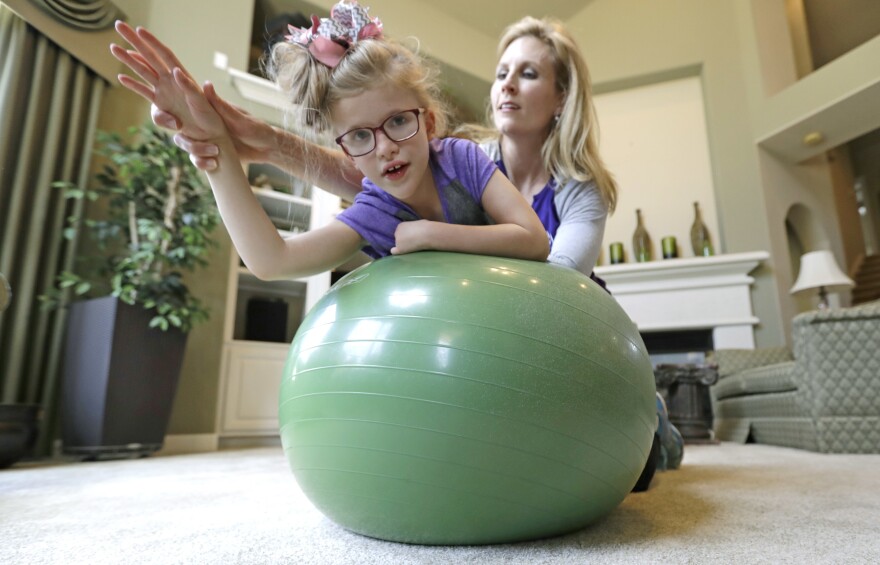Across Texas, some school districts are now offering teletherapy services to students with disabilities. It's the first large-scale launch of its kind, so teachers and therapists are having to get creative to meet the needs of these students.
The sudden loss of routine and structure can be disorienting for these kids, said April Estrada, director of special population services in Region 10 — which serves North Texas school districts.
“Overall, the biggest thing just looking from the student perspective, kids love structure and routine whether or not they realize it or not,” she said. “I think the biggest challenge right now is to have that disrupted and that especially impacts our special education students as much as it does everyone else.”
Gov. Greg Abbott is expected to share an update soon about when or if the state’s public schools will reopen this year — which could make adapting to virtual learning even more important.
Teachers are encouraging students to use visual schedules that they can easily reference throughout the day. They’re also offering parents sample schedules and guidance on how to manage their child’s time.
Estrada said therapists are also showing parents how to make do without the tools usually available at school.
“Go into your kitchen and we can tell you 10 things to do with your Tupperware that might be able to be used in our lessons,” she said.
Region 10 lead physical therapist Dr. Lois Goodin said household items can easily be made into fun activities while working on things like motor skills.
“For instance, if they don’t have a lot of balls around they might roll up some socks and play games with those, or throw those into laundry baskets for targets and different things like that,” she said.
Limitations Of Teletherapy
Goodin admits that teletherapy can be tough to pull off, particularly for her specialty: physical therapy.
“We’re used to hands-on kind of things so it’s challenging for us for sure,” she said.
Speech therapists also face obstacles. Debi Buchanan, who's the Garland school district’s executive director of special education, said it can be hard for students to learn certain sounds without hearing and watching therapists in-person.
She said she’s seen messages from teachers trying to prepare lessons on articulation. They’re asking questions like, “How do I provide lessons on saying R’s correctly?” she said.
Buchanan said therapists also have an added responsibility — finding a way to clearly communicate with parents. Since they can’t be there to apply the therapy in person, parents often have to step in.
Buchanan said it’s not easy for parents to know how to work with their child the way a trained therapist would. Take tasks like grasping a pencil, where subtle differences matter.
“So if they’re using a piece of equipment or something, they will have the parent find something similar to that in their home and they will show them how that looks and how the students should be interfacing with that,” she said.
But even finding time for parents to help students can be challenging, Estrada said. Many parents have full-time jobs or multiple children at home, which means students with disabilities might not have their full attention.
“If a child needs physical or academic support from an adult, they may only have only certain times in the day when they can be active with their instruction because they might need assistance from an adult to do their work,” Estrada said.
The Upside Of Learning From Home
Goodin said one benefit of working remotely with students with disabilities is that therapists get to see how the student is cared for at home.
“We get to see how the parents are interacting with their child, how they’re able to lift them and how they move them around,” she said.
Goodin said this rare look into a student’s home life provides an opportunity to offer additional help for parents and caretakers — at a time when many are overwhelmed.
Physical therapists like Goodin are consulting with families on issues like how to position their kids, many of whom aren’t independently mobile, for school work. She said they’re also giving parents ideas on how to ensure students just have time to play.
“You know I was on with a family yesterday who the child uses a walker,” Goodin said. “And he took a walk down to the creek and went fishing in the middle of the day to break up their schoolwork.”
Some students are even showing more of their personalities, she said. One young boy, who is nonverbal, usually keeps to himself at school. But at home, Goodin said he seemed more lively and relaxed than she had ever seen him before.
“He was yelling at his mom and dad and laughing and playing a little bit more,” she said. “So kids are just different in their home environments, so that’s fun to see that we get to do through virtual sessions that we normally don’t.”
Stories like these give special education professionals hope. While virtual school and therapy aren’t ideal, this time may provide students with disabilities and parents with some positive memories that will last long after the coronavirus pandemic.





